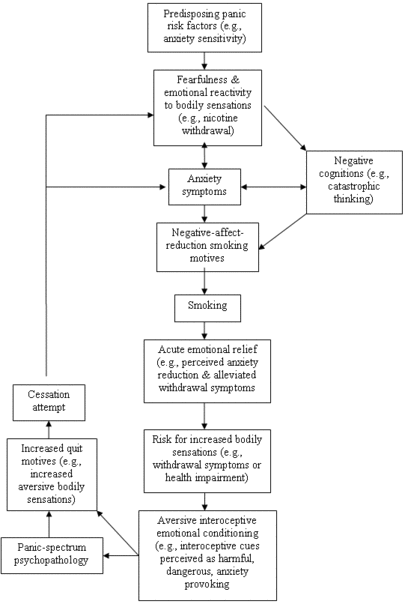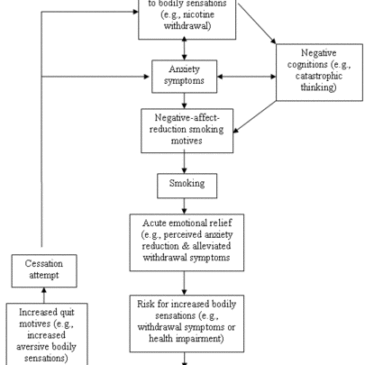Among patients diagnosed with panic disorder, between 19% to 56% have been estimated to be current smokers (Zvolensky, Feldner, Leen-Feldner, & McLeish, 2005). There tend to be fewer current smokers among people with other anxiety disorders, such as social phobia and obsessive-compulsive disorder (Lasser et al., 2000). Researchers have found that predispositions to panic, such as anxiety sensitivity (i.e., fear of anxiety), might moderate the association between smoking and panic disorder. This week’s ASHES describes an integrative model, created by Zvolensky and Bernstein (2005), that depicts the relationship between panic disorder and smoking. The next ASHES issue will review research that examines one component of this model: the impact of the physical concerns aspect of anxiety sensitivity on the association between smoking status and panic psychopathology.
Research by Zvolensky and colleagues suggests that anxiety sensitivity might moderate the relationship between smoking status and panic disorder. For example, although smokers and nonsmokers with a history of panic disorder exhibit similar anxiety and physiological responsivity to a panic attack, smokers require more time to recover from emotional disturbance: smokers with panic disorder report experiencing significantly more intense anxiety symptoms and interview-based severity ratings of panic symptoms than nonsmokers with panic disorder (Zvolensky et al., 2004). Similarly, Zvolensky and colleagues (2003) found that daily smokers with higher levels of anxiety sensitivity were at greater risk for panic disorders than smokers with low anxiety sensitivity. The influence of anxiety sensitivity is especially visible during cessation attempts. Smokers with high anxiety sensitivity have reported increased intensity of anxiety-related withdrawal symptoms during the first week of their most recent quit attempt (Zvolensky et al., 2005). Similarly, Brown, Kahler, Zvolensky, Lejuez, and Ramsey (2001) found that anxiety sensitivity increased the likelihood of lapsing within one week of quitting.
Zvolensky and Bernstein (2005) created an integrative model (see Figure 1) to depict their hypothesized relationship between panic disorder and smoking. This model suggests that, in most cases, smoking follows panic psychopathology. As anxiety symptoms worsen, the researchers predict that individuals will attempt to manage their mood with smoking; the researchers speculate that for a short period smoking will curb negative affect. However, after an extended duration, smoking might lead to intensified aversive internal cues, (i.e., bodily sensations) resulting in increased anxiety. This possible surge in panic-spectrum psychopathology could augment some individuals’ motivation to quit and initiate a cessation attempt. Unfortunately, the subsequent withdrawal symptoms might once again trigger more intense anxiety symptoms, prompting individuals to return to smoking. According to the hypothesized integrative model, panic-vulnerable individuals can find themselves in a forward-feed cycle in which they utilize smoking to manage anxiety, which can paradoxically lead to greater risk for long-term panic problems.
Zvolensky and Bernstein’s integrative model clearly organizes their hypothesized relationship between smoking and panic psychopathology. Further research is needed, however, to examine the temporal patterns and causal associations among various facets of the model. For example, Zvolensky and Bernstein propose that anxiety symptoms often appear first, but diagnostic studies have indicated that smoking begins between the ages of 15 and 20 years and the median age of onset of panic disorder is 24 years. More work is necessary to understand the chronology of these developments and the ways in which timing influences the proposed cycle. The next ASHES will examine how the specific dimension of anxiety sensitivity, physical concerns, moderates the intricate relationship between panic symptoms and smoking.

Figure. Hypothesized forward-feed smoking-maintenance and panic-risk cycle among panic-vulnerable tobacco users (Zvolensky & Bernstein, 2005). Click image to enlarge.
–Sara Kaplan.
References
Brown, R. A., Kahler, C. W., Zvolensky, M. J., Lejuez, C. W., & Ramsey, S. E. (2001). Anxiety sensitivity: Relationship to negative affect smoking and smoking cessation in smokers with past major depressive disorder. Addictive Behaviors, 26, 887-899.
Lasser, K., Boyd, J. W., Woolhandler, S., Himmelstein, D. U., McCormick, D., & Bor, D. H. (2000). Smoking and mental illness: A population-based prevalence study. Journal of the American Medical Association 284, 2606-2610.
Zvolensky, M. J., & Bernstein, A. (2005). Cigarette smoking and panic psychopathology. Current Directions in Psychological Science 14(6), 301-305.
Zvolensky, M. J., Feldner, M. T., Leen-Feldner, E. W., & McLeish, A. C. (2005). Smoking and panic attacks, panic disorder, and agoraphobia: A review of the empirical literature Clinical Psychology Review, 25, 761-789.
Zvolensky, M. J., Kotov, R., Antipova, A. V., & Schmidt, N. B. (2003). Cross cultural evaluation of smokers risk for panic and anxiety pathology: A test in a Russian epidemiological sample. Behaviour Research and Therapy 41, 1199-1215.
Zvolensky, M. J., Leen-Feldner, E. W., Felder, M. T., Bonn-Miller, M. O., Lejuez, C. W., Kahler, C. W., et al. (2004). Emotional responding to biological challenge as a function of panic disorder and smoking Journal of Anxiety Disorders, 18, 19-32.
What do you think? Please use the comment link below to provide feedback on this article.





Panic disorders May 6, 2009
Panic disorders are very common in society today and the number of people suffering from them has increased in the United States.